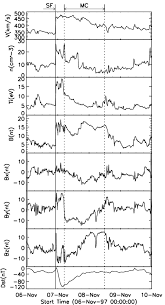Exploring Geomagnetic Storms and Their Effects

Introduction to Geomagnetic Storms
Geomagnetic storms are disturbances in the Earth’s magnetic field that occur due to solar activity, particularly solar flares and coronal mass ejections (CMEs). These storms hold significant importance as they can affect various technologies—including power grids, satellites, and communications—critical to modern life. Recent events have raised awareness about the potential impacts of geomagnetic storms, making it a timely topic of discussion for scientists, policymakers, and the public.
Understanding the Causes
Geomagnetic storms originate from the sun’s activity. When the sun emits high-energy particles during a solar flare or CME, these particles can interact with Earth’s magnetic field, causing fluctuations. Solar Cycle 25, which began in December 2019, has shown increased solar activities, leading to heightened concerns about the potential for geomagnetic storms. Notably, in early September 2023, a significant geomagnetic storm was recorded, rated at G4 on the NOAA scale, illustrating the potential severity these storms can reach.
Effects on Technology
The effects of geomagnetic storms can be widespread. One of the most immediate impacts is on power grids. In 1989, a severe geomagnetic storm caused a nine-hour blackout in Quebec, affecting millions. In recent years, utilities have strengthened their infrastructure within a framework of better predictive tools to mitigate such risks. Furthermore, satellites in orbit may experience malfunctions or damage due to increased radiation from geomagnetic storms, leading to disruptions in GPS and communications systems.
Impact on Space Weather
Geomagnetic storms are a critical component of space weather, which can affect astronauts and space missions. Increased radiation levels during these storms pose risks to astronaut safety, necessitating contingency measures for upcoming missions. NASA and other space agencies are continuously monitoring solar activity and advising space crews on potential hazards related to geomagnetic storms.
Conclusion and Future Outlook
Understanding geomagnetic storms is crucial as society becomes increasingly reliant on technology. With the ongoing solar cycle and predictions indicating heightened solar activity, it is essential for businesses, especially those in power and communications, to enhance their resilience to such events. Continuing research and monitoring of solar activity will play critical roles in predicting geomagnetic storms, enhancing preparedness, and mitigating potential disruptions to our daily lives. As we move forward, public awareness and investment in infrastructure resilience will be paramount to cope with the impacts of these fascinating yet disruptive natural phenomena.







